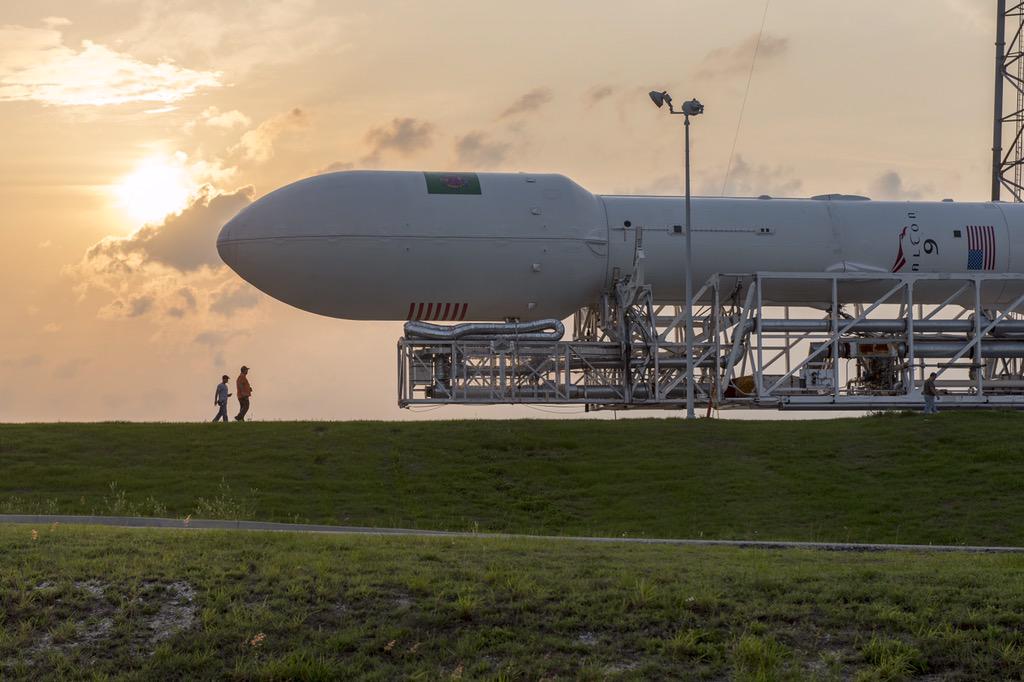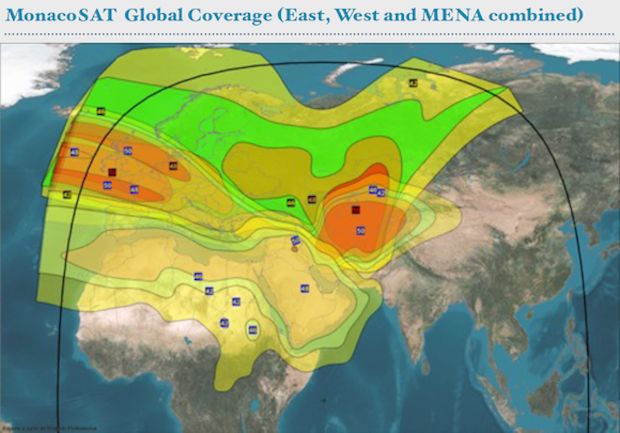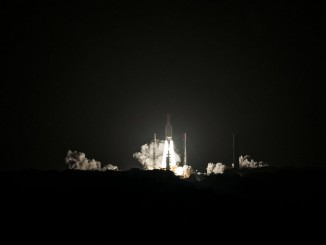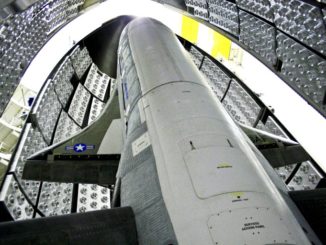
SpaceX ground crews transferred a Falcon 9 rocket to its seaside launch mount at Cape Canaveral on Sunday evening in preparation for liftoff Monday with Turkmenistan’s first satellite.
Liftoff is set for 6:14 p.m. EDT (2214 GMT) Monday from Cape Canaveral’s Complex 40 launch pad. The launch window extends for 90 minutes.
The European-built communications satellite fastened inside the Falcon 9’s payload shroud will relay signals for Turkmenistan’s Ministry of Communications.
The satellite’s launch comes as Turkmen authorities renew efforts to forcibly remove privately-owned satellite dishes from apartment buildings, according to Human Rights Watch.
“A move that unjustifiably interferes with the right to receive and impart information and ideas, this serves to further isolate people in Turkmenistan, one of the most closed and repressive countries in the world, from independent sources of news and information,” Human Rights Watch said in a statement Friday.
Officials with the international human rights watchdog organization suspect the government crafted the order to remove the dish antennas to restrict access to outside news sources, such as Radio Azatlyk, a Turkmen language affiliate of U.S.-funded Radio Liberty.
The Falcon 9 will target delivery of the satellite — named TurkmenAlem52E/MonacoSat — into an egg-shaped geostationary transfer orbit. SpaceX has not revealed the altitude and inclination parameters of the orbit.

Weather forecasters predict a 60 percent chance of favorable weather during Monday’s launch window, with meteorologists citing concerns over thick clouds and cumulus clouds over Central Florida.
If the rocket does not get off the ground Monday, the weather forecast slips to just a 30 percent probability of acceptable conditions Tuesday.
The 224-foot-tall Falcon 9 rocket — emblazoned with the U.S. flag on one side and an emblem with the colors of the Turkmen flag on the other — will be fueled with refined kerosene and liquid oxygen propellants Monday afternoon, put through a series of preflight tests, then handed over to computer control in the last 10 minutes of the countdown.
Nine Merlin 1D main engines will ignite moments before liftoff. If the engines pass an automated health check, hold-down restraints will release and the Falcon 9 will climb away from Florida’s Space Coast powered by 1.3 million pounds of thrust.
The rocket will break the sound barrier and streak into the stratosphere before letting go of its nine-engine first stage less than three minutes after blastoff.
SpaceX does not plan to recover the Falcon 9 booster after Monday’s launch because the flight profile requires all of the rocket’s fuel to deploy the payload into orbit.
The Falcon 9’s upper stage — fitted with a single Merlin engine optimized to operate in space — will ignite for the first of two burns needed to inject the TurkmenAlem52E/MonacoSat spacecraft in the correct orbit.
The rocket’s 17.1-foot diameter clamshell-like nose cone will jettison at the flight’s four-minute point, and the second stage engine will shut down nine minutes into the mission after reaching a temporary low-altitude parking orbit.
The engine will fire again after a 17-minute coast for approximately one minute, then the rocket will turn for separation of the satellite about 32 minutes after liftoff.
Ground stations will listen for signals from the spacecraft to confirm its health following the launch, then Thales engineers will oversee a series of burns by the satellite’s own rocket thrusters to adjust its orbit.
The orbit-raising burns will nudge the satellite farther from Earth and move its orbital path over the equator, where the craft’s velocity will match the rate of the planet’s rotation. Thales will park the spacecraft along the equator at 52 degrees east longitude, a geostationary slot registered to Monaco by the International Telecommunications Union.

The operating location and Monaco’s role in the mission help give the TurkmenAlem52E/MonacoSat satellite its unusual name.
In exchange for permitting the spacecraft to reside at 52 degrees east, Monaco’s government secured the use of 12 Ku-band transponders on the satellite. Luxembourg-based satellite operator SES signed an agreement with Space Systems International-Monaco, an entity licensed by Monaco’s government, to commercialize the 12 Ku-band transponders.
Another 26 transponders on the satellite are reserved for exclusive use by Turkmenistan, according to SSI-Monaco.
With a launch mass near 4,500 kilograms — 9,920 pounds — the satellite is based on the Spacebus 4000 C2 spacecraft bus built by Thales, which will turn over control of the satellite to Turkmen authorities in the coming weeks.
“Once operational in orbit, TurkmenAlem52E/MonacoSat will allow Turkmenistan to operate its first national satellite telecommunications system, ensuring enhanced, secure telecommunications for the country,” Thales wrote in a mission summary posted on the company’s website.
The satellite will reach users across Central Asia, Europe and Africa, with a coverage zone spanning more than 90 countries. It has enough fuel to stay on station for more than 18 years.
Thales said it built the satellite and had it ready for shipment in 27 months. The launch was set for November 2014, but delays in SpaceX’s manifest kept the satellite from launching until this month, according to Thales.
As part of its contract with the Turkmenistan Ministry of Communications, Thales manufactured the spacecraft, provided ground support equipment for two satellite control stations, selected SpaceX as the launch services provider and procured insurance coverage.
Thales also trained Turkmen engineers to operate the satellite once it is in orbit.
SpaceX and Thales announced the launch deal in June 2013 after original plans to send up the satellite on a Chinese Long March rocket were blocked by U.S. regulators due to laws restricting the export of sensitive technology to China.
Although the TurkmenAlem52E/MonacoSat satellite was assembled in Europe, it contains components from subcontractors in the United States.
Follow Stephen Clark on Twitter: @StephenClark1.



